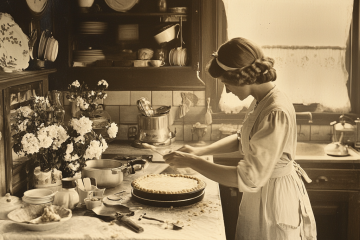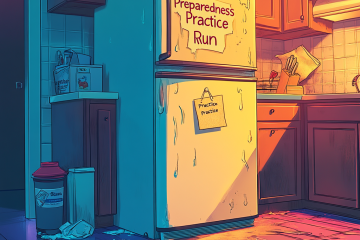Backyard Hunting–By Guest Contributor Sharon Cundiff
My husband and I enjoyed the festivities for opening day of the Cincinnati Reds, walking through the park that parallels the river with my sister-in-law and her niece. The path wanders through and around trees, bushes and flowers, when suddenly a darting object caught my eye as it seeks refuge under the bushes. I froze as the others continued walking ahead. A fat bird starts to dart out from under the bush, suddenly it spotted me, and darted back in! I do the move and freeze dance and the bird, I guess thinking I was walking on, does its dart through and out of the bushes dance. By this time everyone has realized that I am not with them, and turn around to witness my spastic performance.
The nine year old niece decides it looks like great fun and flits back to my position. She asks me what I was looking at and I answered “That fat bird.” She asked me why, and I answered that I wondered what it tastes like! I continued to tell her that the behavior of the bird is quite unusual. Instead of taking to the sky, it took refuge on the ground. It was as interested in my strange movements, as I was in its. The reason I was curious as to its flavor was because it was fat and would be easier to catch as it was on the ground in the event that I was very hungry and couldn’t go to the grocery store. I further postulated that it could be a fat mama bird protecting its nearby nest by decoying me away from her eggs. If that was the case, I wondered what the eggs tasted like! Finally, I have never seen a bird like it before, (I live in Texas) and wanted to know if its behavior was typical. If it wasn’t typical behavior, then I would want to know that so I WOULDN’T eat it, as it could indicate illness and I wouldn’t want my food to come from a sick animal. The little girl looked at me, smiled, giggled and skipped off.
Further on our walk we spotted geese and she said “Aunty Sharon… I wonder what they taste like?” I told her they taste very good. She rubbed her stomach, licked her lips, and exclaimed “yummy!” then skipped off again. I got her! I got her thinking that there were other ways to obtain food other than the grocery store!
As a practitioner of the self-reliant arts, I found myself wanting to keep “livestock” in order to assure a continual supply of fresh meat, not only for rotating through long term storage but to supply us with a local, organic, nutrient dense, non-gmo tainted, complete protein source. The limiting factor to this desire is my location. We live in Suburbia, USA. The houses are fairly close to each other and the only thing keeping me from looking straight into our neighbor’s family room from the comfort of my bed, is a six foot wooden privacy fence. Our home is one story, in a cul-de-sac, sitting on a 70’x 120’ lot surrounded on three sides by two story homes.
 After much research into such “crops” as miniature goats, aquaponics, even miniature cows (yes, there is such a thing!) I decided upon rabbits. They are quiet, take up little relative space, breed proverbially, and birth to harvest weight is a markedly short amount of time. All of those facts also reveal the low cost in both time and labor. Although we now have a full fledge meat breeder housing set up for our herd, the first two years we used regular rabbit hutches we picked up on the cheap through craigslist. There are chores with rabbits that are required in addition to daily watering and feeding. Because they are so quiet, their ears, feet, eyes and general body condition need to be monitored. Typical ailments found in domestic rabbits are ear mites, and sore hocks. Their teeth are always growing, and in the wild they chew on wood. We provide blocks of untreated pine for them to gnaw on. Don’t go to the pet store and buy those artificially dyed, miniscule packets, of carrot shaped wood. You will spend a ton of money on those attractive items when it makes not a bit difference to the animal. Lastly, what should be included in this brief overview as to their care is nail trimming. Generally we trim nails right before we breed.
After much research into such “crops” as miniature goats, aquaponics, even miniature cows (yes, there is such a thing!) I decided upon rabbits. They are quiet, take up little relative space, breed proverbially, and birth to harvest weight is a markedly short amount of time. All of those facts also reveal the low cost in both time and labor. Although we now have a full fledge meat breeder housing set up for our herd, the first two years we used regular rabbit hutches we picked up on the cheap through craigslist. There are chores with rabbits that are required in addition to daily watering and feeding. Because they are so quiet, their ears, feet, eyes and general body condition need to be monitored. Typical ailments found in domestic rabbits are ear mites, and sore hocks. Their teeth are always growing, and in the wild they chew on wood. We provide blocks of untreated pine for them to gnaw on. Don’t go to the pet store and buy those artificially dyed, miniscule packets, of carrot shaped wood. You will spend a ton of money on those attractive items when it makes not a bit difference to the animal. Lastly, what should be included in this brief overview as to their care is nail trimming. Generally we trim nails right before we breed.
There is way too much information that would require decisions when considering meat rabbits, which cannot be covered in this expose’. Other topics include, rabbit breeds, what to do with all that poo, (hint: composting and vermiculture,) extreme weather conditions, the science of breeding, nesting boxes, weaning, housing the juniors, reasons for culling, methods of dispatch, and location/setup of butchering station, butchering tools, how to dispose of guts and what to do with the hides.
 Our initial herd was all Californian. We then switched it up by adding a Chocolate Rex and finally added specially bred New Zealands. These NZ’s were developed through Texas A&M Kingsville to be heat tolerant. We breed heavily September through May and not at all May through September. Far and away the worst part in raising and harvesting meat rabbits is NOT the raising and harvesting! It is the breeding! They are caged after all. The lack of the innate thrill of the chase and wide open space is stressful to their natural instincts. Breeding is a two person job, in case they need to be separated quickly and you do not enjoy getting bitten! This brings me to another benefit.
Our initial herd was all Californian. We then switched it up by adding a Chocolate Rex and finally added specially bred New Zealands. These NZ’s were developed through Texas A&M Kingsville to be heat tolerant. We breed heavily September through May and not at all May through September. Far and away the worst part in raising and harvesting meat rabbits is NOT the raising and harvesting! It is the breeding! They are caged after all. The lack of the innate thrill of the chase and wide open space is stressful to their natural instincts. Breeding is a two person job, in case they need to be separated quickly and you do not enjoy getting bitten! This brings me to another benefit.
We are a home school family and our kids participate in every part. As breeding is an all day affair, (taking the doe to the buck three times and taking multiple does to the buck) often breeding day was a week day. Our son or daughter provided back up during those times. As I mentioned, this is the worst part – it is not only stressful for the rabbits, but for the breeder as well. Add teenagers to the mix and they termed it “Bunny Porn!” AHHHH que the Lion King – The Circle of Life!
 The next part is our family’s personal favorite – Kindle Day! The day the momma’s give birth! We count and check them several times daily; looking for those that didn’t make it, and ensuring all are getting fed. At times we have had to remove dead ones, and switch some kits around to other mothers, (this happens when one has a huge litter and another has a smaller) After some time of observation we have even had to cull the weak or deformed ones. We are farmers, not pet owners. Within five weeks we have removed the nesting boxes and begun weaning the kits. We house the kits in our “condo” unit that is built to hold 2 rabbits in each apartment that are up to 5 lbs. each. The next breeding cycle for the does can occur as little as two weeks after weaning.
The next part is our family’s personal favorite – Kindle Day! The day the momma’s give birth! We count and check them several times daily; looking for those that didn’t make it, and ensuring all are getting fed. At times we have had to remove dead ones, and switch some kits around to other mothers, (this happens when one has a huge litter and another has a smaller) After some time of observation we have even had to cull the weak or deformed ones. We are farmers, not pet owners. Within five weeks we have removed the nesting boxes and begun weaning the kits. We house the kits in our “condo” unit that is built to hold 2 rabbits in each apartment that are up to 5 lbs. each. The next breeding cycle for the does can occur as little as two weeks after weaning.
 We harvest the kits when they reach 5lbs. approximately another seven weeks after weaning. For us, this next part gets a little tricky. Remember we live in Suburbia, surrounded by two story homes and neighbors who enjoy their back yards? This is another two person job. First we scout along the fences to see if anyone is outside, then I grab a rabbit with a towel, while the second person has a high powered pellet gun which was loaded and pumped inside of the house. This second person follows me to the side of the house, that borders our only one story neighbor, where we have a small short enclosure. While walking to the location, the pellet gun is held with the butt end under the armpit, muzzle pointed down, in the hand closest to our house in an effort to conceal it. One time our neighbor’s child came out while we were walking to the side of the house and started to jump on his trampoline. He asked “what are you going to do with that rabbit? I turned around, placed the rabbit back in the condo and answered “nothing, the Governor called!” You can’t shoot a rabbit in the base of the skull in a small enclosure on the side of your house with the neighbor’s kid jumping on the trampoline!!!!! That is exactly how we dispatch our livestock, without onlookers. Following the shot, we grab the rabbit by its hind legs while the animal completes the death throws. (all automated nervous system, muscular reactions) This allows the animal to bleed out. We then bag the rabbit head down, and reverse the conceal process back into the house.
We harvest the kits when they reach 5lbs. approximately another seven weeks after weaning. For us, this next part gets a little tricky. Remember we live in Suburbia, surrounded by two story homes and neighbors who enjoy their back yards? This is another two person job. First we scout along the fences to see if anyone is outside, then I grab a rabbit with a towel, while the second person has a high powered pellet gun which was loaded and pumped inside of the house. This second person follows me to the side of the house, that borders our only one story neighbor, where we have a small short enclosure. While walking to the location, the pellet gun is held with the butt end under the armpit, muzzle pointed down, in the hand closest to our house in an effort to conceal it. One time our neighbor’s child came out while we were walking to the side of the house and started to jump on his trampoline. He asked “what are you going to do with that rabbit? I turned around, placed the rabbit back in the condo and answered “nothing, the Governor called!” You can’t shoot a rabbit in the base of the skull in a small enclosure on the side of your house with the neighbor’s kid jumping on the trampoline!!!!! That is exactly how we dispatch our livestock, without onlookers. Following the shot, we grab the rabbit by its hind legs while the animal completes the death throws. (all automated nervous system, muscular reactions) This allows the animal to bleed out. We then bag the rabbit head down, and reverse the conceal process back into the house.
I have a simple, portable butchering station that I set up in my kitchen. A board covered in plastic has two cup hooks installed at the top and propped against the counter. A lined five gallon bucket is placed at the bottom with the plastic from the board covering pouring into it. Everything is kept cleaned and sanitized throughout the butchering process. I have excellent knives! (my personal favorite part!) Truly by the time the animal is in the house the entire gutting and skinning process is nearly blood free and hasn’t any odors! Time elapsed from dispatch to cooling is twenty minutes. The dressed out rabbit is placed in a cooler filled with ice water and kept there until the rigor mortis process is completed, approximately 2-3 days. It is imperative that it remains iced the entire time. We hang the hide to dry out on a clothes line in the garage. Please note: do not open your garage door when the neighbors are around. Dangling hides are not your typical garage fare!
Taking my time, I can process fifteen rabbits within three days. Inside of a week I have placed thirty two rabbits into freezer camp! One doe, on a consistent breeding schedule, can produce 320 lbs of meat in a year! A doe can do so for four to five years before it starts to diminish. Bucks can breed forever, except I have found that captivity encourages a buck to become… “lazy.” I have culled a buck every two years for such a reason. A family of four can use one rabbit for two meals. Once my family became three, we were able to use one rabbit for three meals. From one rabbit I make a main dish such as chicken fried rabbit or rabbit and dumplings, a casserole – that my family named rabbit kick-assarole, and bone broth that we use for soups, consumption for health reasons or to replace that horrid stuff grocery stores sell professing to be broth or stock and sold in cans or boxes.
I am an outdoor enthusiast. Camping, hunting, fishing, kayaking are all things that make life so very sweet and I have done so my entire life. By way of a calling – I am a teacher. I have taught friends, youth organizations, and at NRA events, how to shoot, hunt and have given them some of the skills to self sustain when placed in the great outdoors. I know why the Lord has placed this farmer girl in a suburban setting and that is to be an example of how one can partake of earth’s enumerable bounties, even when the mega mart is mere blocks away! I may not have access to acreage filled with deer and the like, but I still can hunt and put meat on the table consistently with my herd of rabbits all in my back yard!



2 Comments
Northwoods Cheryl · May 28, 2014 at 12:37 am
When I was a child we lived
When I was a child we lived in a similar situation in town, and raised enough rabbit to feed a family with 9 children! We also used a pellet gun to initially kill the animal. Us kids were frequently sent on our bikes to fish to add a different type of protein to the table. We also shot pigeons off our grandparents’ barn roof and pressure cooked them. We all remember those days fondly!
junipers · May 28, 2014 at 5:43 pm
My parents raised ducks and
My parents raised ducks and pheasant. The 1st yr was tough with a steep learning curve. They learned by trial and error. They built a pond and stocked it with trout. Every night after supper, we’d go down to the pond and visit a couple of the ducks they freed. We named the ducks “suppertime” and feed the fish with Purina trout chow. Supper time and her babies came back every year for a while. Thank you for your article. As my parents learned: theirs a lot more to it, than building a caged in area for game.
Comments are closed.